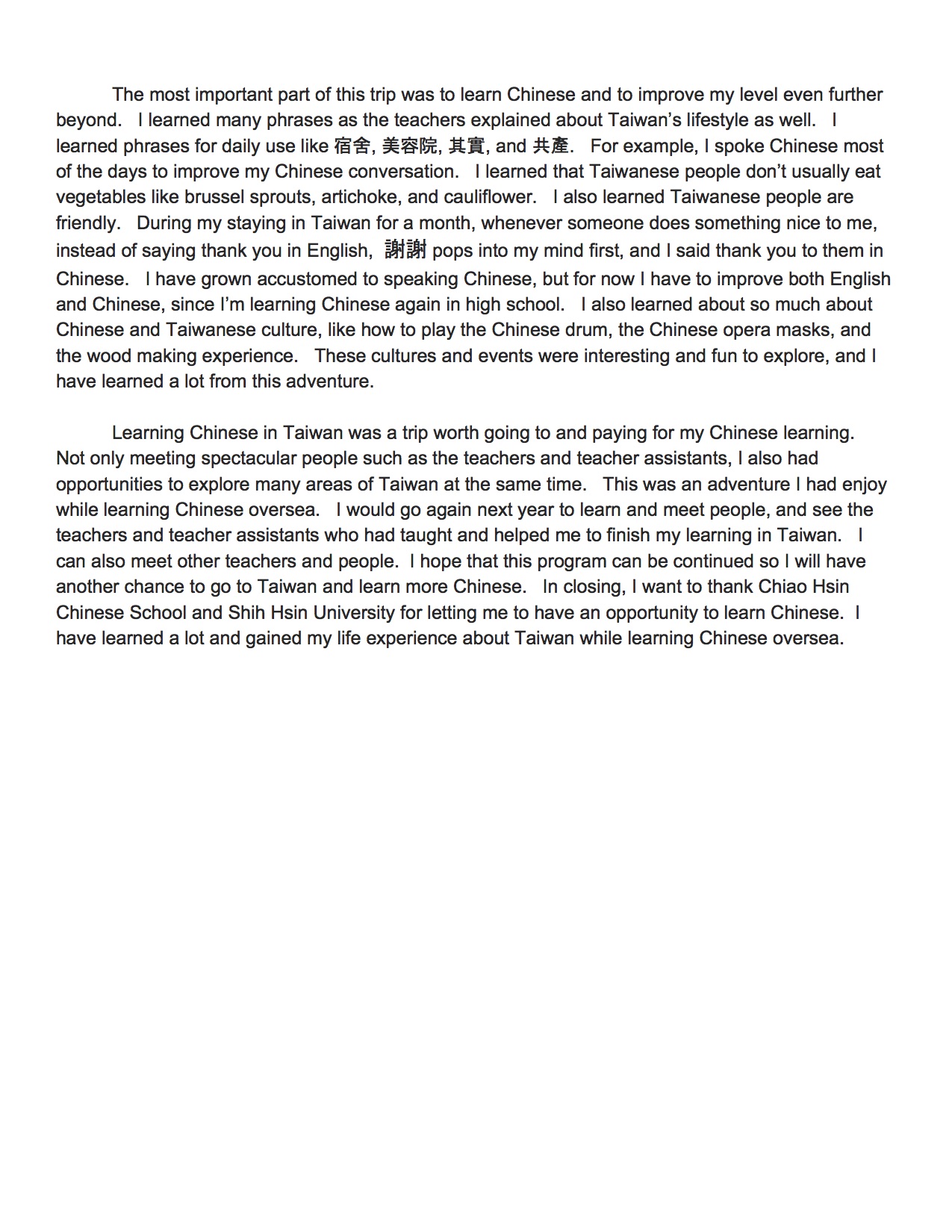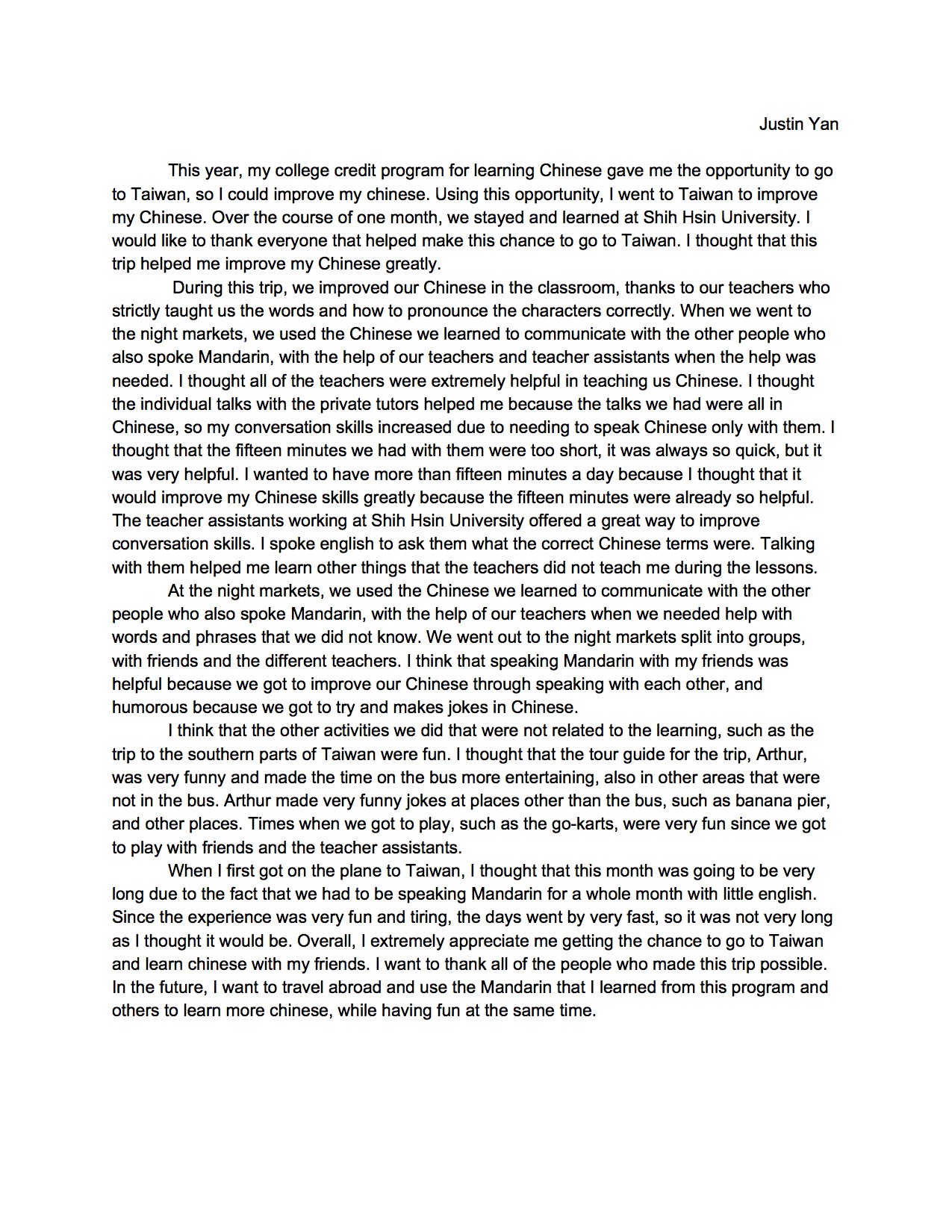我愛台灣 中級班 王俐人
在6月2號我上了一架飛機,這飛機會帶我去台灣。我去台灣不是去玩的,並去台灣是要在一個大學學中文跟中華文化。這個旅程我永遠不會忘記。雖然我很興奮去台灣但是我有一點緊張。說真的我很害怕,我也開始懷疑自己的中文能力,想到許多無用的問題,例如如果月底到了但是我沒有進步?如果這大學課程我失敗了?如果我讓大家傷心?當這些想法在我的腦海裏打架,我終於得出一個結論。不管發生什麼事,我最後一定要是第一名。我一定要每天做功課考試的時候要得90分到一百分。這次的留學會將來改變我的生活,當飛機起飛,我心裏準備好了。
首先,我低估台灣的習慣和天氣。上第一天的課時,我期待得是將有很多艱苦的作業,但令人驚訝的,我們學的東西沒有那麼難,我有一點失望。但隨著日子一天天過去,而我不是想要更多的功課,fan 兒是希望少一點。我開始懷疑自己的能力。不過,我朋友們,新或舊,跟我老師們的友愛給了我勇氣。月底的時候,我的口音,翻譯,閱讀,口語的能力都進步了。我在台灣,學非常多,比如說我學了台灣的歷史。這個國家從前是殖民地,後來在1930年宣布獨立了。我也學了大陸實行共產主義,台灣實行三民主義。我學了很多困難詞,例如競選、勢力、默契、錄取、⋯⋯。算起來,我學了一百多詞,考了110個新詞左右。我也學了兩首中文歌,一個是五月天的OAOA,第二個是周杰倫的青花瓷。這兩首歌中,我最喜歡周杰倫的青花瓷,因為它的旋律優美而富有詩意。我很高興,有機會可以唱這首歌作我們的表演。我自己也學了五月天的我不願讓你一個人,雖然我獨唱這首歌,我還是最愛青花資。
在世新大學,遇到了很多新的朋友,看到了世新的美麗風景,學到了許多中文。我一定會保存所有的珍貴的回憶。我特別想感謝我的老師們,我很自豪地說建龍老師、佩瑜老師是我的老師,因為他們不僅教我如何使用我們在日常生活說的詞,他們也讓我成為一個更好的人。我永遠感謝他們的悉心照顧和支持。最後我想說,當我回美國,我很想再回台灣去學習。我愛台灣!
——————————————————————————————————–
到台灣學習中文 初級班 林智杰
本來我很怕來台灣,因為我想學中文很難,我做不到。第一個禮拜,我覺得我每天很累,我不喜歡上課,我也不喜歡做功課,可是從二個禮拜,我想通了,我的父母希望我學中文。所以我告訴自己我可以做得到。之後我上課時侯開始專心了,我的老師對我很好。台灣的人很和氣,跟他們說話很舒服。週末的時侯我出去逛逛,還吃很多好吃的小吃。我們去很多地方我看到很多有趣的東西。我最喜歡的地方是台北一零一,我喜歡一零一,因為他很現代,而且買東西很方便。台灣食物非常好,很便宜又很好吃。我很喜歡吃台灣的牛肉麵,我希望我每天都吃。我喜歡台灣的火車,因為洛杉磯沒有。我也很喜歡去夜市,因為夜市有很好喝的珍珠奶茶。最後一個禮拜我們去墾丁。我覺的墾丁很好玩我希望我們能留更長的時間。我們回來的時候,我很傷心,我想念我的老師。我希望我們下次還可以回去台灣。
———————————————————————————————–
鍾文銨
台灣遊學
我很喜歡我們的台灣遊學之旅,因為我的朋友和我一起去外國遊學。 我最喜歡在夜市走路,因為可以看到很多人,而且可以吃很多的特別的食物。我在世新大學學了很多的中文。 我覺得我在台灣的時候學到很多的東西。 我在台灣的時候,我覺得買東西不是最重要的事情,所以我很小心花錢,因為我不想浪費父母的錢。 有一個同學不到兩個禮拜就用光他的錢,因為他想買太多的東西且他要買紀念品給他的朋友。下次我要還要去,因為跟我的朋友一起學習很有趣,你一個人做一個事情很孤單,但跟你的朋友一起做,可以讓你很開心。跟我們的台灣留學一樣很好玩,因為我的朋友跟我一起去, 一起玩,一起學中文。 我很喜歡在親水公園玩,跟朋友玩真的很有趣。 在上課的時候,我很喜歡學中文,因為我們的老師教的教法很有趣,所以老師的教法讓我學到很多的新的中文。 我覺得我最喜歡的做的事是吃台灣的特別的食物,因為台灣的食物很好吃,而且很多食物在美國吃不到,所以下次我要再去台灣。
—————————————————————————————-
CHIAO HSIN 2016 TAIWAN STUDY ABROAD SUMMER SESSION
Even as a young boy, I dreamed of traveling to China. This baffled my parents, as our family is not of Chinese descent. America, it is said, is the “great melting pot” and my own lineage typifies this: I have ancestors from the Mediterranean, Eastern Europe, Northern Europe, Mexico, and the indigenous Americas. While it is wonderful to have a familial connection to so many different cultures, I have found that the sheer fact that I am so mixed dilutes the potency of any cultural identity or affiliation. To wit, I am unable to speak any of my ancestral languages, and have little ties to the “mother countries” aside from the historical and biological. However, my hometown in America boasts a strong and vibrant Chinese immigrant population. Growing up in Alhambra, it was impossible not to notice the beautiful Chinese signs(漢字) lining the streets and businesses, the joyous parades during the Spring Festival, and the sounds of the different Chinese dialects one could hear walking down the street. I have always been slightly envious – not that I wished I was Chinese – but rather that the Chinese immigrants in Alhambra had a culture of such strength and beauty that it was able to thrive and flourish in America.
When I was eighteen, the opportunity to study Mandarin Chinese presented itself, and I jumped at the chance. I studied Chinese at Chiao Hsin Chinese Language School for nearly two years. Later, I worked at the school as an English and Math tutor and teacher. All the while, I admired Chinese culture and dreamed of traveling to Asia. When I became aware of Chiao Hsin’s trip to Taiwan, I begged to go along with the group.
During the trip, our group studied Chinese at Shih Hsin University through their Center for Teaching Chinese as a Second Language. Our classes ran Monday-Friday for four weeks and we were occupied with studying nearly all day. My comprehension and spoken Chinese made great improvements In the evenings, we would frequent the local Jing Mei night market. I don’t think that I’ve ever had more delicious food in my life! During the weekends, our group took many day trips. We were fortunate enough to see much of Taiwan. One afternoon, we went to see Tamsui (淡水) which was quite beautiful and I was quite partial to the Fisherman’s Wharf. We also went to Yilan to enjoy the National Center for Traditional Arts. In Miaoli, we hiked to see the Lonsheng Fallen Bridge and visited the Hakka Culture Park. In particular, I found the trip to the Hakka Culture Park highly educational, as I was previously unfamiliar with many of the distinctions of Hakka Culture. In Yingge, we visited the “old street” and looked at some of the famous pottery. In Taipei, we visited the National Palace Museum, Chiang Kai-Shek Memorial Hall, Sun Yat-sen Memorial Hall, and Taipei 101. We went shopping at the famous Ximending District and at the Shilin Night Market.
Reflecting upon the trip to Taiwan, there were many things which surprised me. In particular, I was surprised at the extent to which the Japanese Colonial Period influenced the modern infrastructure of the country. I have long been marginally aware of the history of the region, but seeing the old railway systems, old streets, and many other buildings from this period surprised me. In addition to the historical influence of the Japanese colonial period, I was surprised at the extent to which corporate globalism has shaped modern Taiwan. The view walking down the streets of Taipei is not drastically different from the modern streets of New York City.
The most lasting impression I have of Taiwan is that its people are intelligent, hospitable, and friendly – patient with me as I was practicing Chinese in my day-to-day interactions. The city of Taipei is modern, efficient, and cleaner and safer than nearly any large city in America. The public transportation system is enviable, but a necessity given the population density. Although the humidity can provide quite a workout during the summer months, the hot and wet climate provides the island with the resources to house jungles of greenery and beauty. I am determined to return again to visit before too long.
Vincent M. Johnson
——————————————————————————-
黃頌恩
————————————————————————————————
—————————————————————————




